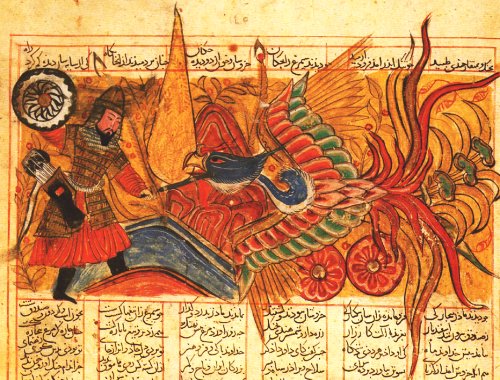
|
|
Combat between Isfandiyar and Simurgh, from Firdawsi's Book of Kings,
circa 1330.
Unlike his tricksteresque counterparts Pazuzu and Imdugud/Anzu in Sumer, the Simurgh is known as a beneficial bird-being. The Simurgh is sometimes compared to a phoenix, but is also described (as with Pazuzu and Imdugud/Anzu) as a lion-bodied creature with wings and a bird's beak. The touch of the Simurgh, or one of its feathers, could heal a man instantly, and apparently the Simurgh had knowledge of how to prepare a special restorative brew known as houma. According to Persian myth, the Simurgh lived in the Tree of Knowledge, again tying it to the myth of the Anzu, which made its nest in the Huluppu tree. According to the Occultopedia, "When the Simurgh took flight, it was said, its powerful ascent shook the tree's branches so violently that the seeds [from every plant that has ever existed] were scattered throughout the world, bringing a wealth of valuable plants to mankind. Later, according to myth, the Simurgh nested in seclusion on the sacred Persian mountain of Alburz, far beyond the climbing abilities of any man." This ties the Simurgh to creation myth, similar to the story of Melek Ta'us breaking apart the cosmic egg to create the world -- and to the Watchers' eventual banishment to remote regions of the desert (or the sky) after their contact with mankind went awry. According to Pantheon.org, "According to legend, the creature is so old that it has seen the world destroyed three times over. In all that time, Simurgh has learned so much that it is thought to possess the knowledge of all ages." This seems closely connected to the specialized knowledge the Watchers were said to have had -- and which they passed on to humans, a forbidden act much in the same way that eating from the Tree of Knowledge was a forbidden act. |